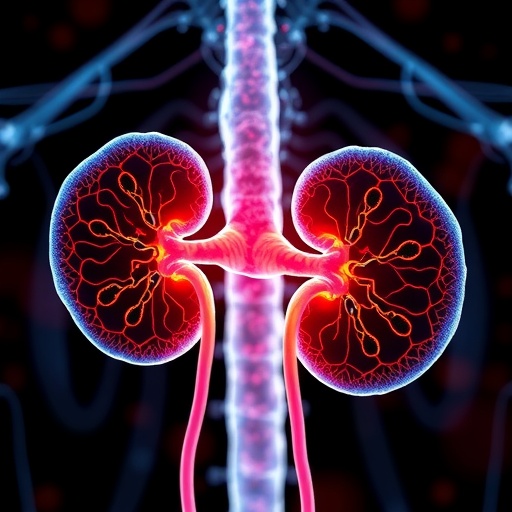In an enlightening study exploring the intersection of renal health and diabetes management, researchers R.K. Tomar, V. Mehalingam, and P. Adole have unveiled significant insights into urinary netrin-1, a lesser-known biomarker with the potential to revolutionize our understanding of type 2 diabetic nephropathy. This research not only sheds light on the potential implications of netrin-1 levels in clinical practice but also raises intriguing questions about the underlying mechanisms of renal function in diabetic patients. As diabetes continues to rise worldwide, innovative diagnostics are critical to improve patient outcomes and tailor treatments more effectively.
Type 2 diabetic nephropathy poses a major threat to individuals suffering from diabetes, often leading to end-stage renal disease. The disease often develops subtly and may go unnoticed until significant damage has occurred. Thus, early detection is paramount. Currently, routine tests, including serum creatinine and albuminuria measurement, are utilized, but these may not fully capture the nuances of kidney health. The work of Tomar et al. shines a light on netrin-1, a protein associated with nerve guidance and inflammation, which may play an unexpected role in renal dysfunction.
Netrin-1 functions primarily as a neuroguidance molecule, influencing neuronal growth and patterning during the development of the nervous system. However, recent studies have suggested its involvement in the inflammatory processes and fibrosis associated with renal injury. The current research delves deep into the correlation between urinary levels of netrin-1 and renal function indicators, revealing a potential relationship that holds promise for developing targeted therapeutic interventions.
The study consisted of a comprehensive assessment of urinary netrin-1 levels in a cohort of patients diagnosed with type 2 diabetes. The objective was clear: to determine whether there is a significant correlation between elevated urinary netrin-1 and the extent of renal damage, as evaluated through traditional markers like the glomerular filtration rate (GFR) and serum creatinine. Initial findings indicate a remarkable association, suggesting that netrin-1 could serve as a biomarker for kidney health in diabetic populations.
By analyzing urinary samples from patients, the researchers utilized advanced quantitative techniques to accurately measure netrin-1 levels. The robust nature of their methodology ensures that the data collected is both reliable and reproducible, lending credence to the findings. They compared the results across different stages of diabetic nephropathy, providing a nuanced view of how netrin-1 levels fluctuate in correspondence with renal impairment, thus illuminating a potentially critical pathway mediating kidney damage in diabetes.
The implications of this research extend beyond mere statistical significance. If urinary netrin-1 can be further validated as a biomarker, it could significantly alter clinical practice by allowing for earlier intervention in diabetic patients. This shift could help prevent the progression of nephropathy, which often leads to dire complications, including dialysis and transplantation, disrupting countless lives. Moreover, understanding the mechanism through which netrin-1 affects the kidneys could pave the way for novel therapeutic strategies aimed specifically at diabetic nephropathy.
The study also touches upon the biological pathways that netrin-1 may influence in the context of renal health. Inflammation, fibrosis, and cell apoptosis are all critical factors in the progression of nephropathy. If netrin-1 is indeed playing a role in these processes, it opens a new frontier for researchers and clinicians alike to explore potential treatments that can modulate this biomarker, potentially slowing down or even halting the progression of kidney disease in diabetic patients.
Moreover, the research by Tomar and colleagues highlights the necessity of interdisciplinary approaches in addressing complex diseases like diabetes. The blend of nephrology, endocrinology, and molecular biology stands as a testament to how collaborative efforts can yield groundbreaking insights. Understanding the interplay between biochemical markers and the physiological state could lead to more personalized medicine, where therapies are tailored specifically to an individual’s biomarker profile.
Contextually, this study aligns perfectly with increasing global efforts to combat diabetic complications. As the prevalence of diabetes continues to escalate, so too does the urgency for innovative solutions that can be implemented at the patient care level. Policymakers and healthcare systems alike will benefit from the information gleaned from this research, as they seek to allocate resources effectively to manage the burgeoning epidemic of diabetes and its myriad complications.
As we cautiously embrace these findings, it is important to also remain circumspect. More extensive longitudinal studies will be necessary to truly ascertain the role of urinary netrin-1 in the clinical management of type 2 diabetic nephropathy. Establishing causation, rather than mere correlation, will be essential in solidifying the place of netrin-1 in routine clinical assessments. Nevertheless, the groundwork laid by this study represents a significant step forward in renal research within the context of diabetes.
In conclusion, the work of Tomar, Mehalingam, and Adole highlights an exciting and dynamic field at the crossroads of endocrinology and nephrology. As the medical community eagerly awaits further studies to validate these promising findings, urinary netrin-1 emerges as a standout candidate for enhancing our understanding of diabetic nephropathy and ultimately improving patient care outcomes. This research holds the potential not only to change diagnostic approaches but also to instigate a broader dialogue around the molecular pathways that govern renal health in the face of an ever-growing diabetes crisis.
Research into urinary biomarkers such as netrin-1 is an essential part of the ongoing evolution of disease management strategies, ensuring that new avenues of exploration continue to challenge existing paradigms. As scientists and clinicians work hand in hand, the promise of innovative treatments that can improve the quality of life for those affected by diabetes becomes increasingly attainable.
With a keen focus on early detection and intervention, the future of managing type 2 diabetic nephropathy looks promising. Studies such as this reinforce the importance of investing in research that stands to greatly impact patient health, creating a ripple effect that benefits not only individuals but the healthcare system as a whole.
Subject of Research: Urinary netrin-1 levels in type 2 diabetic nephropathy.
Article Title: Utility of urinary netrin-1 levels in patients with type 2 diabetic nephropathy and its correlation with renal function.
Article References:
Tomar, R.K., Mehalingam, V. & Adole, P. Utility of urinary netrin-1 levels in patients with type 2 diabetic nephropathy and its correlation with renal function.
BMC Endocr Disord 25, 252 (2025). https://doi.org/10.1186/s12902-025-02049-1
Image Credits: AI Generated
DOI: https://doi.org/10.1186/s12902-025-02049-1
Keywords: urine biomarker, diabetic nephropathy, netrin-1, renal function, type 2 diabetes.
Tags: albuminuria measurement challengesdiabetic nephropathy biomarkersearly detection of kidney diseaseend-stage renal disease riskimplications of netrin-1 in clinical practiceinnovative diagnostics for diabetesmechanisms of renal functionneuroguidance molecules in renal healthrenal health in diabetesserum creatinine limitationstype 2 diabetes complicationsurinary netrin-1 levels





